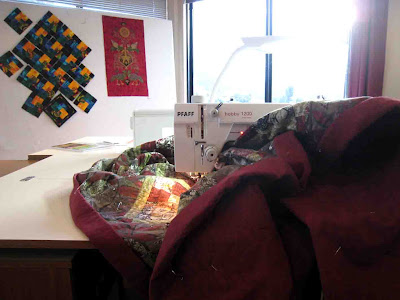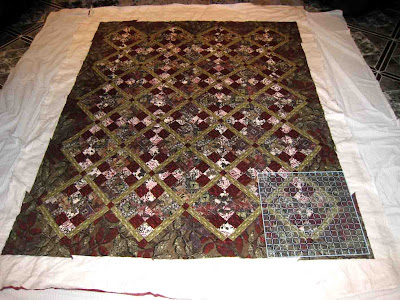A quote from the book - I took the bait!
I read through the instructions, which looked horribly complicated. I decided to try to work this out for myself instead - not a particularly intelligent decision on my part. Carrie suggests using the Creative Grids Side Set Triangle Ruler - which I did, and it really makes doing the triangles easy.
With the blocks laid out on the design wall, I simply slipped the ruler into the space, took note of the measurements and started cutting. They are sewn in exactly the same way as the frames around the blocks.
They look like the newspaper hats my Dad used to make for me.
Not too difficult - the hardest part is deciding where to put the frame. I followed Carrie's lead, placing them so they looked like they run behind the block. (Actually trying to get them to run around the block was much trickier - I tried it and failed).
All done - time to sew the rows together
CORNER TRIANGLES
Now comes the fun part. The instructions in the book use graph paper to figure out how to place and construct these, so that the frame turns the corner. This wasn't going to work for me, as the pattern, rulers and instructions are all in inches. The only graph paper I can find around here is metric with cm grids.
Instead I made a template the size I wanted and set to work trying to put these together. Oh dear. There may not have been tears, but there was some language as colourful as the quilt!
My first attempt was too small and the frames didn't match.
Hmmm - I need to re-think my technique here...............
I worked really hard on getting this right, and was getting frustrated with the results. I concluded my problem was not that I didn't know what to do, but that I lack the sewing skills to do it. I muddled my way through, using my template and my un-picker. Follow the pictures to see what I did...........
You need to make 2 triangles per corner - my bunch of mini pirate hats!
Tah-dah!
I got there in the end. This is a technique which for me, is best learned in person - it would be so much easier to learn this hands-on - to watch how it's done before attempting it myself. Even a video would help!
So here is my somewhat wonky framed quilt. It's not perfect but I'm pleased I had a go.
"This was a bit of work, but well worth it for what these triangles add to the edge of the border. Congratulations for trying!"
Another quote from the book - you're certainly making us work hard Harriet!
QUILT AS DESIRED
All through the making of this quilt, I've been pondering on how to quilt it. My first thought was that it's such an angular pattern, that some curves were needed. Then it occurred to me that this is a contemporary looking quilt and also made for a man, so straight lines would be fine. I like what Carrie has done with hers - she has a combination of grids in the blocks and a curvy design in the triangles. It may be a while before I quilt it as I ponder how best to do it. Meanwhile, it's time to make a sandwich.
This is a very small quilt. Really small. I found it a handy size to work out my batting and backing sizes on the design wall.
The backing width is fine - just need to cut the length
Set the backing over the batting and cut to size - handy dandy!












































